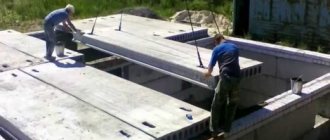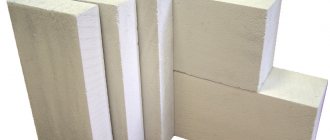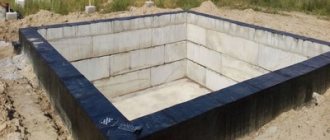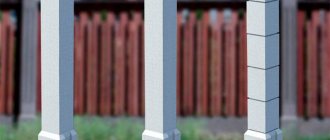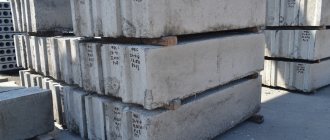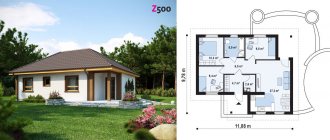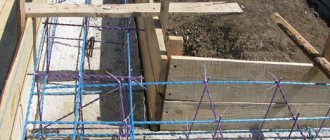Prefabricated structures help to significantly reduce the construction time of any structure. Foundation blocks are usually intended for the construction of buildings with basements. They form the walls of the underground part of the building, at the same time being the basis of the future house. Foundation blocks can be solid or hollow. And they are made from heavy, porous or silicate concrete.
Features and advantages of foam blocks
This material is becoming increasingly popular in the construction market. It has its own technical characteristics and special qualities.
The main advantages of foam blocks:
- Reliability
. Foam blocks are not subject to any external influences. They have truly stone strength and can be used for a long time, maintaining the internal structure. - High heat resistance
. This property can significantly reduce heat loss in winter. In summer, in hot weather, the size of the foam block and its structure make it possible not to allow high temperatures to pass through. Thus, an even microclimate is created inside the building and the required level of air humidity is maintained. - Environmental friendliness
. In this parameter, foam blocks are second only to wooden structures. If we take the environmental coefficient of wood as one, then for a foam block it will be 2, for sand-lime brick - 8, for ceramic brick - 10. - Quick installation
. Due to their low density and light weight, foam blocks are laid many times faster compared to the same volume of brickwork. One cube of foam blocks weighs much less than 1 m3 of brick. This process is further simplified, since the dimensions of the foam blocks for building a house are precisely measured. Thus, the speed of masonry work directly affects the total cost of construction and installation work. - Soundproofing
. These products are capable of high-quality sound absorption. According to this parameter, the size of foam blocks for partitions is almost twice as effective as brick or conventional reinforced concrete. - Fire safety
. Foam blocks are non-flammable materials. They reliably localize fires. The tests carried out allowed us to assign this material the first degree of fire resistance.
The process of laying foam blocks is not much different from laying ordinary bricks
Disadvantages of the material
In addition to the advantages, expanded clay concrete blocks have certain disadvantages:
- The exterior may require further cladding.
- When building large structures, it is necessary to correctly calculate the strength and grade of material.
- A large number of handicraft industries with products that do not comply with GOSTs and specifications.
- Due to the high porosity of expanded clay concrete, the blocks are inferior in strength to heavy concrete.
- Ventilation of the walls is more difficult than in the brick version.
These disadvantages can be minimized if you choose the right type of blocks for construction, which should only be purchased from a reliable manufacturer.
Use on unstable soils
The use of foundation concrete blocks is possible on any type of soil. However, if we are talking about unstable soil, such as heaving, swampy, technogenic, peat, then when arranging a foundation of concrete blocks, you should follow some recommendations. So, the blocks are immersed in the ground below its freezing point. They are equipped with a suspended grillage. At the request of the developer, it can be made of wood, metal or reinforced concrete.
Often this construction technique is used in the construction of frame and wooden buildings.
The process of laying a foundation from blocks in the video:
Types of blocks according to GOST: FBS, FBP, FBV, FL and BF
For the construction of a technical underground, basement walls, installation of columnar and strip foundations, construction of walls of low structures, unheated buildings and other structures operating under systematic exposure to temperatures from +50 to -70 degrees, concrete blocks can be used, which, based on GOST 13579-78 There are three types: FBS, FBV and FBP. Products are made from silicate, heavy concrete or expanded clay concrete. Their density should not be less than 1800 kg/m³.
FBP - blocks with one- or two-sided voids for laying communications.
According to the transcript, FBS is a foundation wall block with a maximum safety margin. When manufacturing monolithic small elements, structural reinforcement is not used. Metal is used only for the manufacture of hinges for installation. In the production of dimensional blocks, longitudinal reinforcement rods are necessarily used, which increases the weight of the FBS.
FBV blocks, unlike the previous type, have a longitudinal section in the cavity of the product. It is intended for installation of engineering communications. The manufacturing process of such products is similar to the manufacturing method of the previous version. Here, concrete of at least grade M100 is used. However, in the construction of FBV blocks are used extremely rarely, therefore they are manufactured mainly to individual orders. Products are available in lengths of 880 mm, heights of 580 mm and widths of 400, 500 and 600 mm.
Foundation blocks do not have reinforcement with the exception of embedded mounting loops.
FBP blocks are hollow lightweight concrete products that have open square holes in the lower part of the element. Concrete grade M150 is used for production. Products are produced in lengths of 2380 mm. Other linear dimensions of foundation blocks and prices for products are in a wide range. FBP blocks are used to create foundations for industrial equipment or to construct internal basement walls.
As a base for a columnar or strip foundation FBS, trapezoidal-shaped products are used, which are marked FL. The parameters and dimensions of foundation pads are regulated by GOST 13580-85. The width of the products varies between 600-3200 mm. The height of the elements can be 300 or 500 mm. The last value corresponds to products with a width of 2000 mm. The length of the block is 780-2980 mm. The largest elements have dimensions of 2980x2000x500 and 1180x500x3200 mm, and the smallest are available in sizes 1180x600x300 mm.
For the construction of internal and external walls of structures of agricultural and industrial enterprises, reinforced concrete strip blocks BF made of heavy concrete are used, which are regulated by GOST 28737-90. All elements are divided into six varieties, which differ in their cross-sectional sizes.
Installation of a strip foundation made of trapezoidal blocks, which are marked as FL.
Where is the void type used?
A hollow concrete block can be used to construct load-bearing walls of a building, provided that it is a low-rise building . That is, a 2- or 3-story house, garage, barn, utility room, technical structure, industrial facility or building for other purposes can be built from this material. The load that the material will experience will not be excessive.
But high-rise buildings are not recommended to be constructed from hollow elements. They are not intended for such purposes and the result of using the blocks for other purposes will be the destruction of the building.
Hollow-core elements are excellent for laying partitions, curtain walls, lintels indoors, as well as the construction of fences, retaining walls and other enclosing structures.
To arrange the shallow foundation of a building or basement, you can use hollow concrete products, but an important condition for this is to lay reinforcement bars in the voids or fill them with concrete.
What are FBS blocks?
FBS literally stands for “foundation wall blocks.” These are reinforced concrete products of various shapes and sizes with high performance and strength characteristics. Thanks to these properties, concrete blocks are widely used today in the construction of heavy-duty foundations.
The main materials for the manufacture of FBS blocks are concrete grades M150, M200, expanded clay concrete, silicate concrete and class A-III reinforcement. As a result, different types of FBS blocks have their own specific characteristics. For severe operating conditions, preference is given to blocks made of concrete grade M200.
Types of FBS blocks and their sizes
The main function of FBS blocks is to hold huge loads. Not every reinforced concrete product can cope with this task equally well. Therefore, concrete blocks are usually divided into three main types: FBP, FBS and FBV.
- FBS are solid reinforced concrete blocks with maximum strength characteristics. It is this type of FBS blocks that is used for laying foundations.
- FBV - concrete blocks of this type are not much different from the previous one, with the exception of a special cutout, which is intended for communications.
- FBP is a brand of hollow block up to 2.4 meters long. Blocks of this type have a lightweight design, which allows them to be used for the construction of walls.
| FBS BLOCKS • DIMENSIONS | WIDTH mm | HEIGHT mm | LENGTHmm | Weight, kg |
| FBS 24.6.6 | 800 | 580 | 2380 | 1960 |
| FBS 24.5.6 | 500 | 580 | 2380 | 1630 |
| FBS 24.4.6 | 400 | 580 | 2380 | 1300 |
| FBS 24.3.6 | 300 | 580 | 2380 | 970 |
| FBS 12.6.6 | 600 | 580 | 1180 | 960 |
| FBS 12.5.6 | 500 | 580 | 1180 | 790 |
| FBS 12.4.6 | 400 | 580 | 1180 | 640 |
| FBS 12.3.6 | 300 | 580 | 1180 | 460 |
| FBS 12.6.3 | 600 | 280 | 1180 | 460 |
| FBS 12.5.3 | 500 | 280 | 1180 | 390 |
| FBS 12.4.3 | 400 | 280 | 1180 | 310 |
| FBS 9.6.6 | 600 | 580 | 880 | 700 |
| FBS 9.5.6 | 500 | 580 | 880 | 590 |
| FBS 9.4.6 | 400 | 580 | 880 | 470 |
| FBS 9.3.6 | 300 | 580 | 880 | 350 |
The existing GOST FBS blocks defines up to 15 standard sizes of these products
At the same time, an important distinguishing characteristic of concrete blocks is their standard width, which varies from 300 to 600 mm. The length of FBS blocks is: 880, 1180, 2380 mm, and their height can be 280 or 580 mm
Standards
Foundation blocks are produced taking into account the standards prescribed in GOST 13579-78. Here are the following:
- structural types of concrete products;
- specifications;
- dimensional parameters;
- requirements for materials;
- permissible deviations;
- rules relating to acceptance and control;
- methods of storage and transportation.
Hollow blocks are produced under the FBP brand. In their body, along a length equal to 2380 mm, there are blind recesses that do not reach the closed edge of 30 mm. The height of the products is 580mm, and the width is 400, 500 and 600mm. The voids at the entrance have a rectangular cross-section, narrowing as they deepen. Their sizes:
- along the length at the entrance - 430mm, at the bottom - 350mm;
- width at the entrance - 160, 220 and 320 mm, depending on the width of the foundation blocks;
- depth – 550mm.
Foundation blocks have symbols indicating the type of product (in our case - FBP), three sizes in decimeters, rounded up, type of concrete and GOST number. For example: FBS 24.5.6-S GOST 13579-78. Such marking is considered standard, although industry regulations have the right to slightly change it.
The type of concrete means:
- T – heavy;
- C – has medium density (silicate);
- P – made using porous aggregates (expanded clay concrete).
All of the listed types of material are used for the production of foundation blocks with voids. The relationship between the type of concrete and its compressive strength class for FBP:
- for heavy and expanded clay concrete – B12.5;
- for silicate – B15.
The reference mass of products, in this case, is:
- from heavy concrete – 1.05…1.4t;
- from silicate – 0.88…1.17t;
- from expanded clay concrete - 0.79...1.05 t.
Frost resistance, as well as water resistance of concrete, is accepted according to building codes, depending on the climatic conditions of the region and the type of operation of the foundation. These explanations are given in the design documentation
Particular attention is paid to the geological conditions of the construction site. In particular, an important parameter is the aggressiveness of the environment
After research, adjustments are made to the requirements for the composition of the concrete mixture from which the products will be made.
All foundation blocks with voids are equipped with two P2 mounting loops. They are a reinforcing bar bent in a certain way with a diameter of 10 mm. GOST presents drawings and dimensions of loops. They are installed in special recesses at a distance of 80mm from the end of the block. There should be no concrete sagging on the surface of the protruding part of the rods.
Permissible deviations
Standards define tolerances for linear dimensions in both directions:
- length – within 13mm;
- width – within 8mm;
- height – within 8mm.
The straightness of the surfaces should not deviate by more than 3mm along the entire length or width of the foundation blocks. In addition, their body is not allowed to have cracks other than minor surface defects.
Ceramic block or porous warm ceramics
This porous ceramic block is produced using the same technology as bricks and from the same materials. The whole difference is that the “body” of the material is not solid, but consists of voids and ceramic bridges. This structure is effective: for central Russia, a wall made of porous ceramics should be 50 cm. The same thickness of a wall made of aerated concrete is also needed. And additional insulation is not required with such a thickness. That is, the wall will be single-layer, which is much better than multi-layer. And the finishing can be made from facing bricks or clinker. Ceramics will “make friends” with ceramics without any problems. But not everything is so rosy.
Hollow blocks for ceramic walls could be considered the best option, if not for the high percentage of damage and difficulties with fastening
Advantages and disadvantages of ceramic blocks
The main advantages were listed - good thermal characteristics and low (compared to ordinary or even hollow brick) weight. But ceramics are fragile things. And thin partitions break and break easily. When transporting, you can get about 10% of the battle. In addition, cutting a ceramic block is not so easy. A saw won't help here. Other, more serious equipment is required. Another disadvantage is that special fasteners are required, since only this can be held in thin walls.
| Advantages of ceramic blocks | Disadvantages of hollow ceramic blocks |
| Good thermal insulation properties | Brittle material that chips and breaks easily |
| High level of sound insulation | Requires special tool for cutting blocks |
| Average water absorption | Requires special fasteners |
| Steam conductivity | The blocks are not as big compared to lightweight concrete |
| Good frost resistance | Non-ideal geometry, high cost for polished ones that have stable dimensions |
| High strength | |
| The presence of a corrugated surface, which increases the thermal resistance of the masonry. | |
| High heat absorption. It works as a large heat accumulator, but this is bad for building periodic heating houses. |
Other advantages are the same as those of brick: natural ceramics, average water absorption, frost resistance from 30 to 80 cycles, good sound insulation properties - up to 55 dB, which is a very good indicator. In addition, there is such a thing as heat capacity. It shows how much heat the material can accumulate. The more heat it “accepts” into itself, the longer it will take to release it later. For homes with permanent residence, materials with high heat capacity are more comfortable. And for ceramics it is quite big. Such a wall is a kind of heat accumulator. This is good for a permanent home, but bad for a dacha that is visited only occasionally in winter. Warming up takes a lot of fuel and time. So this building block is not the best for dachas or baths.
It is also worth adding that today the cost of a cube of porous ceramic block and the cost of autoclaved aerated concrete are almost the same. In some places, aerated concrete is even more expensive. But the sizes of aerated concrete blocks are larger, glue consumption and time consumption are less. You can argue about the time, since for ceramics the presence of armored belts is not necessary, but it will not be superfluous either. And you can’t argue with the size of the blocks. And with geometric precision. No, there are polished ceramic blocks that are adjusted to fit. They can be installed with a minimal layer of adhesive. But such blocks are much more expensive. Nevertheless, looking at all the facts, it is worth saying that we all know ceramics. So, all other things being equal, it makes more sense to choose it.
Lightweight blocks for construction made from porous ceramics have good characteristics, but may have cracks, which do not contradict GOST. Some manufacturers change this material without problems. Others don't consider it a marriage
Everything is so, but there is one problem. Ceramic block is a type of brick. And according to GOST, non-through cracks are allowed in brick if they do not affect the strength. This is true for solid brick. The presence of small cracks on one side is not considered a defect and does not affect the quality of the masonry in any way. But if there is a crack in one of the faces of the ceramic block, it will obviously not be as strong. Second. When one of the faces is broken, it diverges and the sides are no longer parallel. It is hardly worth using such a block in masonry, although technically this is not a defect.
The best blocks for construction for 2022
Taking into account the raw materials used during production, there are several types of blocks for construction. Such products are:
- Concrete;
- Gas silicate;
- With the addition of various compounds (expanded clay, polystyrene, foam, gypsum).
When choosing a block, it is necessary to take into account such points as the climatic features of the area in which the building is being built, the type of foundation used when building the house. In addition, different of the above types of products have their own specific application, which should also be taken into account when selecting such building materials. When choosing blocks, you should also take into account their following technical characteristics:
- Strength criteria. This parameter refers to the ability of the product to cope with a variety of external physical influences. The main criterion in this case is the brand of product, which indicates the maximum level of permissible load (kg/cc).
- Frost resistance level. This criterion (Мрз) indicates the number of complete freezing cycles, as well as the so-called thawing of the product, which it can endure without collapsing.
- Density. Indicates the level of pressure of the erected wall directly on the foundation of the building. Means the weight of the volume of one unit of the block (kg/cub.m).
- Thermal conductivity level. This criterion indicates the rate of heat flow transfer through the building material. It is worth noting that the higher the level of thermal conductivity, the less heat will be retained inside a building built from this building material.
- Moisture absorption indicator. This indicator indicates the ability of the selected building material to absorb a certain amount of moisture. Compared to simple bricks, this indicator for blocks is at a low level. It is for this reason that walls and buildings made from different types of this building material must be finished using facade materials.
In addition, when choosing blocks, you should pay attention to such criteria and indicators as shrinkage and cost. It is worth noting that when using them, regardless of the chosen type of building material, it is imperative to reinforce the masonry (windows, doorways, and so on).
On a note! The warmest building materials are those made from foam concrete and aerated concrete. When constructing so-called load-bearing walls of buildings, it is recommended to use blocks whose density is more than 800 kg per cubic meter. However, when choosing the density of a building material, one should take into account the fact that the higher this indicator, the greater will be the level of its thermal conductivity.
Advantages
The most positive characteristics of hollow concrete blocks include:
- Little weight. Thanks to this, the load on the foundation is less and transportation is easier.
- Low thermal conductivity. Thanks to the voids, it is easier to retain heat in the room.
- Economical. Due to the voids of raw materials, the production of such blocks requires less, which means the cost is reduced. Another factor is the load on the foundation. Thanks to the light weight of the blocks, there will be less costs for arranging the foundation.
- Presence of holes. Convenient place for communications.
Such blocks retain heat in a room 2.5 times better than brick. Buildings made from this type of block will last more than 100 years; it is easier to make a foundation, since the structure will be much lighter in weight. As a rule, products are extremely accurate in size, the maximum permissible difference is 2 mm. It is easy to remodel houses from these blocks.
Installation methods
Laying blocks occurs in the same way as laying bricks.
The following technologies can be used:
- Half a block. The structure requires an insulating layer due to its small thickness.
- One brick wide. The most common scheme. During masonry, spoon and tie levels are alternated.
- Well masonry walls. Characteristically, there is a void between the layers, which are filled with insulation. This method allows you to retain heat indoors.
Advantages of concrete foundation blocks
The qualitative characteristics that the 200x200x400 concrete block has provide a number of positive aspects when using the material in construction.
- There is no need to hire additional labor and rent special equipment, which, accordingly, reduces the cost of construction.
- Unlike arranging monolithic foundations, there is no need to first assemble and then dismantle the formwork for the foundation.
- The speed of foundation construction is several times higher than when pouring a conventional one.
- Concrete block foundations can be erected at any time of the year
- Immediately after laying the foundation blocks, you can begin to build the walls of the building.
Thus, production by vibration pressing provides products with a decent level of strength, water permeability and resistance to the effects of temperature changes and precipitation.
More massive blocks require additional equipmentSource readmehouse.ru
Average prices for materials
The cost is determined by the brand of cement used in production, the type of expanded clay and the type of block. The most popular product is considered to be M75 , which has sufficient technical indicators for building houses.
| Material type | Amount in a package | Price per piece/rub. | Price per m3/rub. |
| 2-hollow | 90 | 35 | 2100 |
| 3-hollow | 90 | 47 | 2800 |
| 4-hollow | 90 | 40 | 2500 |
| 7 slot | 90 | 43 | 2700 |
| 11 slot | 60 | 69 | 4300 |
| 18 slot | 72 | 56 | 3700 |
| septal | 120-156 | 27-36 | 3400-4300 |
| inter-apartment | 72 | 65 | 3200 |
Production of concrete blocks
The production of fundamental concrete blocks is based on a concrete-based solution. Additional components are introduced into its composition, which give the finished blocks various functional characteristics. The following can be used as fillers:
- Expanded clay
- Gravel
- Crushed stone (hard rocks)
- Slag waste from metallurgy
For fundamental concrete blocks, the size of the fractions of additional materials is very important. They should not exceed 20 mm.
“Shrinkage” of concrete blocks is carried out on special vibratory pressing machinesSource yandex.com
As for concrete, the following are used in the production of standard foundation blocks:
- Autoclaved concrete
- Heavy concrete
The group of autoclaved concretes includes solutions based on gas silicates and aerated concrete. The main binding components in them are cement and lime. Heavy concrete is characterized by increased density.
If it is necessary to provide products with additional clear geometric shapes and increase the strength of finished blocks, the addition of reinforcing elements is used.
Composition and production technology
The main raw material in expanded clay concrete is expanded clay of various fractions. In addition to it, the composition includes such elements as cement, sand, water and other additives designed to improve the quality of the material. And pumice or slag gravel, crushed stone, and sand are used as the main filler.
The use of expanded clay in the composition makes the blocks light, and cement gives them the necessary strength.
The production of expanded clay concrete blocks consists of the following stages:
- mixing all ingredients;
- pouring the prepared solution into molds;
- hardening and hardening;
- drying - takes two days;
- warehousing and preparation for shipment.
Peculiarities
The use of hollow blocks, despite the apparent fragility of the products, increases the reliability of the foundation. The fact is that its safety factor increases due to the reinforcement of the structure with vertical reinforcing bars and as a result of filling the voids with concrete mortar. The blocks, in this case, perform the function of permanent formwork, entering into a fairly rigid monolithic bond with concrete poured inside the structural holes. The foundation is strong and weakly reacts to lateral loads.
Their arguments are as follows. It is impossible to lift the foundation blocks manually, so a construction crane must be ordered to install them. Its work is estimated in machine hours, taking into account downtime, which is not cheap for a private developer. In addition, a truck is needed to transport the products to the installation site, and for the process of installing the blocks itself, a portioned mixture of the solution is required. All these factors influence the rise in cost of construction of a foundation made of hollow blocks.
Prefabricated products have their undoubted advantages. But their full benefit is manifested in the construction of underground parts of high-rise buildings. In this case, the blocks provide:
- speed of masonry - no need to build formwork and wait for the concrete to set completely;
- clear geometry of basement walls due to standard sizes of industrial products;
- declared density and strength.
FBP voids are filled not only with concrete, but also with insulation. This makes it possible to use blocks when constructing foundation walls of unheated basements and even above-ground structures of industrial workshops or utility rooms that are not provided with central heating. In certain cases, hollow blocks are used as protective casings for pipelines of heating systems or water supply. In this case, the space between the pipes and the inner walls of the concrete blocks is filled with heat-insulating foam.
The assortment includes various types of products - solid ones for foundation masonry and hollow concrete blocks used for masonry walls. This material is a modern alternative to brick walls and foundations, while the characteristics of the blocks make it possible to simplify and speed up the construction of any facility.
Pros and cons of use
Any building material has advantages and disadvantages, but hollow blocks have much more advantages than wood and brick.
Advantages of use:
- have lower thermal conductivity and increased noise insulation due to the formation of air pockets during laying;
- rough texture and cavities provide better adhesion of elements to each other;
- good vapor permeability allows the blocks to regulate indoor humidity;
- low weight allows you to save money on foundation construction;
- the material does not burn and does not emit harmful substances when heated;
- Easily amenable to any finishing.
Disadvantages of use:
- internal cavities do not make it possible to attach large objects to the wall without the use of special hardware;
- voids reduce the strength of the material, so blocks are more used for the walls of private houses and low buildings.
Important . Hanging structures cannot be attached to all places. Often these are the upper and lower tiers of masonry, which are filled with a cement mixture. This eliminates the problem of emptiness, which prevents hardware from sticking to the wall.
Gas silicate building blocks: types and properties
When choosing aerated concrete and gas silicate elements, they prefer blocks for small objects and walls or slabs for floors. At the legislative level it is standardized by GOST 31360-2007. Gas silicate elements are made from unreinforced cellular concrete. Designed for the construction of partitions and walls.
Manufacturing is carried out using two methods:
- autoclave method. To dry the material, the influence of steam is used; it is supplied under high pressure. The result is high strength characteristics and resistance to shrinkage during the drying process;
- non-autoclave method. Hardening is carried out under natural conditions. Characterized by significant shrinkage during the solidification process. It is used less often in buildings due to reduced strength, but is cheaper.
You can find out which gas silicate block is by the batch marking. During the masonry process, installation of a vapor barrier film is not required if the air humidity does not exceed 75%. The blocks have standard dimensions: 62.5x50x50 cm. The slabs are made in dimensions: 150x100x60 cm.
Aerated concrete blocks are connected using a special glue, this is facilitated by their ideal geometric shape with an error tolerance of no more than 2 mm
The material is valued due to its technical characteristics:
- arithmetic mean density – up to D700;
- compression force to deformation – from B1.5;
- thermal conductivity level: 0.08-0.1 W/m;
- shrinkage during the hardening process and vapor permeability - corresponds to GOST 31359;
- frost resistance: for external walls F25, for other tasks F15.
The weight of one block starts from 17 kg and reaches 40 kg.
Dimensions
- F - reinforced concrete (reinforced), as well as concrete made of heavy concrete;
- FBS - solid, unreinforced;
- FL - reinforced concrete (reinforced), used for strip foundations;
- BF - reinforced concrete, made of heavy concrete;
- FBP - hollow;
- FR - reinforced concrete, made of heavy concrete, for three-hinged frames.
The dimensions, shape and weight of concrete blocks vary. High-rise buildings require large blocks, while low-rise buildings require much smaller blocks.
Wall blocks in cross-section form a quadrangle; some blocks are produced with additional cutouts. Such blocks are used for the underground and above-ground parts of the foundation. Cushion blocks are trapezoidal in shape (to increase the supporting area), used for laying the first row of the foundation.
Reinforced concrete blocks for foundations are factory-produced products, which means guaranteed quality and identical characteristics of all reinforced concrete blocks of the same brand. The use of foundation blocks can significantly reduce the volume of concrete and cement work, and therefore significantly reduce construction costs.
Solid blocks
Solid blocks are much stronger than hollow blocks, so their most rational use is the construction of external walls with the subsequent installation of ventilation or external facades. The strength of blocks made from cement grades M100-M300 ensures the durability of high-rise buildings, shopping centers, walls of warehouses, workshops, shops; they are also often used to fill openings in monolithic housing construction.
Unlike hollow ones, dowels and anchors in solid blocks hold well due to their dense structure (they do not fly out under critical loads). The standard thickness of walls constructed from solid blocks is 40 cm.
The downside is that heat saving rates are not so high, so they almost always need to be additionally insulated. High density indicates increased weight, which is good in terms of strength, but, on the other hand, such elements are more difficult to install.
Summary
For the construction of internal walls or small buildings, it is wise to use hollow blocks, because their price is lower than that of solid options. Solid ones, in turn, are used in the construction of particularly strong and high-rise structures. For reference: just one sand-cement block replaces 7 bricks, which indicates significant cost savings.
All blocks are characterized by a high level of frost resistance and resistance to other “vagaries” of the weather. Blocks with dimensions of 40x20x20 cm can be wall blocks, which require further cladding, and facade blocks, in which the outer side or both sides have been processed. If the blocks do not require further finishing work, they are usually used for the construction of basements.
Moreover, all products are classified according to texture. Blocks that have not undergone any treatment are usually slightly rough to the touch; If the product is smooth, then traces of processing can be found on its surface.
If, when making blocks, you add colored pigments to the solution, this will allow you to paint them in different colors (as a rule, soot, iron glaze, ocher, and manganese ore waste are used).
By contacting, you are guaranteed to receive a free consultation, consistently high quality products, short delivery and unloading times. For regular customers, cumulative discounts and the possibility of price reductions are provided. To order blocks, please call 8 or email us
How to lay it yourself correctly - step-by-step instructions
The simple installation process is as follows:
- A waterproofing layer of insulator (for example, roofing felt) is laid on the foundation and secured along the entire surface of the perimeter of the future room.
- The first row is laid only on the sand-cement layer, moving from the corners of the perimeter, according to the markings made, using a construction cord.
- The second and subsequent layers do not have to be laid on cement mortar. It is simpler and easier to use construction adhesive, which is applied to the bottom surface of the block with a notched trowel.
- Reinforcement is done every 2 rows. If the blocks are solid and heavy, then they already have reinforcement, so they can be additionally reinforced only if desired, if a very large load-bearing load is expected.
- First of all, load-bearing walls are laid along the perimeter, and only then partition walls.
- The top layer is secured with a dense concrete belt with reinforcement, which is necessary in order to then equip the roof, lintel and floor slabs.
- The resulting excess edges of the blocks are sawed off according to the markings on the wall.
- If further finishing and arrangement of thermal insulation is necessary, after the glue has hardened, dried and gained strength, the surface of the block is ground.
There is nothing complicated about installation, but there is one caveat here - after the walls around the perimeter of the building are erected, the building is left alone for 3 weeks so that the concrete reveals its strength characteristics. Then it will be possible to do the finishing, erect partition walls, and lay a second layer of concrete blocks for better insulation.
Advantages and disadvantages
What it is – concrete wall blocks – is already clear. It's time to briefly clarify their pros and cons.
The main positive qualities include the strength of the material and its cost-effectiveness, ease of work, reduced level of thermal conductivity, and excellent noise insulation characteristics. In addition, the blocks are highly resistant to fire and have a long service life.
Proper operation will provide an object made of blocks with a service life of at least a hundred years, since the material hardly wears out.
The main disadvantage of blocks is that they practically do not deform; it takes at least a year until walls made of such material shrink. It is necessary to remember that the object should be insulated and the blocks should be protected from moisture.

